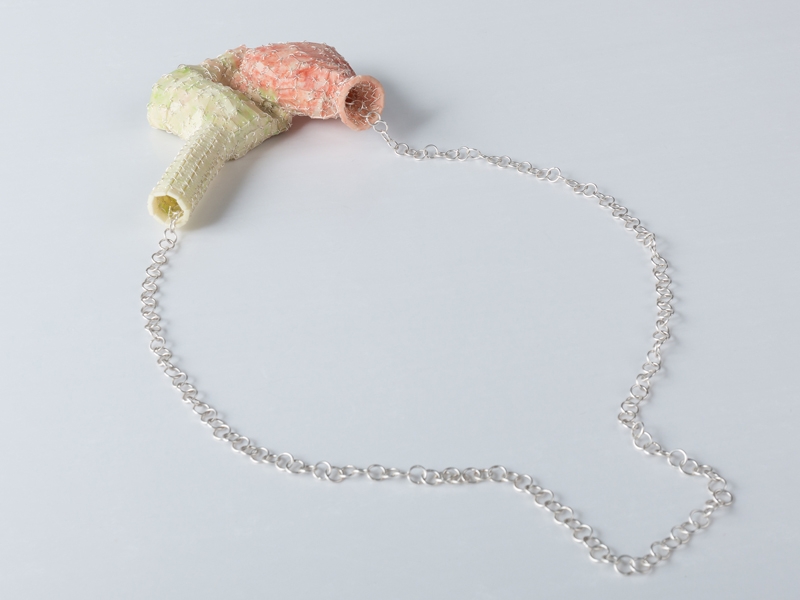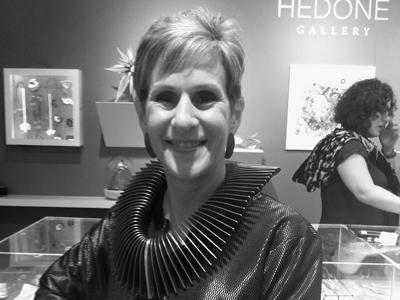For this, the 16th annual AJF Artist Award, the jurors were Swedish collector Inger Wästberg, Australian curator Su san Cohn, and American artist Lynn Batchelder, the winner of the 2016 Artist Award. The jurors met in December and selected the finalists for the 2018 AJF Artist Award from more than 100 applicants. Their choices were based on originality, depth of concept, and quality of craftsmanship. These artists were all 35 years of age or younger at the time of the application deadline. The winner will be announced during Munich Jewellery Week, in March. During the fair, the work of all five finalists will be on exhibit at Platina’s booth in the International Trade Fair hall in Munich, in the Frame area surrounding Schmuck.
AJF asked the finalists to tell us a bit about their backgrounds, the work they submitted for the competition, and their thoughts on the future of the art jewelry field. Here is our interview with Bifei Cao.

Bonnie Levine: Congratulations on being one of the five finalists of the 2018 Artist Award competition—that’s quite an accomplishment! Please introduce yourself to our readers. How did you become interested in jewelry, and what inspires your work?
Bifei Cao: My name is Bifei Cao (Chinese曹畢飛), and I was raised in a small mountain village in Hunan province, in southern China. Thanks, AJF, for allowing me to use two languages for this interview.
大家好,我叫曹毕飞,出生于中国南部湖南省的一个小山村。非常感谢AFJ让我使用双语完成这个采访。
It took me a long time to figure out what I really wanted to achieve in my life. I have always admired my colleagues and fellow artists who pursued jewelry, metals, and other artistic domains for their careers, either in high school or college. I have walked a long road to find that jewelry-based object-making is an enjoyable partner in my life, which is why I pursued several degrees. During my studies, I have deeply appreciated two full scholarships. One was from the Indiana University of Pennsylvania, in the United States, and the other was from Australian National University, in Australia. I also really appreciate my supervisors and friends who support me through this journey of my studies, including Tang Xuxiang, Guo Xin, Lynda LaRoche, Simon Cottrell, Anne Brennan, and Lucy Sarneel.
我花费很多时间才寻找到自己这辈子所属。时常羡慕很多朋友们可以在大学或者高中,甚至更早时间找到人生所向,比如首饰、金属和其他艺术领域。我在人生中慢慢沿途走了这么远才发现,可佩戴的首饰物件创作让我感到开心,以致我乐不思蜀,归于其中。在这段时日里,感激美国宾州印第安纳大学和澳大利亚国立大学的全额奖学金;也感谢很多人生导师和朋友,唐绪祥,郭新Lynda LaRoche, Simon Cottrell, Anne Brennan, Lucy Sarneel,所有的鼓励使我得以前进和继续。
I was trained as a fashion designer in my BA degree, and later switched to be a traditional Chinese metalsmith during my MA studies in China. I then moved to the United States for my MFA studies, and finally to Australia for my PhD in the field of metalsmithing and jewelry. Jewelry-based object-making has become a part of my life.
本科主攻鞋帽箱包设计,研究生转回中国传统金属锻造工艺研究,再到美国攻读金属与首饰MFA学位直至澳大利亚完成博士学位,可佩戴的首饰物件创作已是我生命中的一部分。
Jewelry can be worn as an individual or identity card, which is most important to me as a maker who lives and works overseas. As a transportable object, jewelry imbues personal cultural identity and narrative meanings. Jewelry also brings a triangular dialogue among the maker, wearer, and audience, which fascinates me a lot.
首饰佩戴起来可以作为个人身份或文化身份认同卡,对一个常年旅居海外的人尤其重要。作为可以移动的物件,首饰被赋予了个人文化身份背景和叙事性含义。同时,首饰非常独特地带来一种三角状态的诠释,即创作者、佩戴者和欣赏者的交流。
Cultures and places have consistently inspired my work. As a person from a poor family in a rural village, I am lucky that I could be a global traveler through a journey to the United States, Australia, and different countries of Europe. My immersion in a multicultural environment has allowed me to absorb different cultural references, but at the same time has created conflicts with my original cultural roots. Probably because of my childhood life experience in a rural mountain village that preserved so many Chinese traditions, I have kept different traditional habits and customs from my grandmother and also kept my curiousness of outside worlds. When facing different cultures and places, the search for cultural identity became significant in my research of human beings, concepts, and cultures.
文化和地域对我作品影响至深。从一个农村的贫困家庭中走出来,我很幸运地成为一个全球化的旅行者,历经美国、澳洲和欧洲不同的国家。沉浸于多文化的环境赋予我感受这些新的文化来源,也同时与我母体文化产生冲突。也许正是中国农村的环境保留了很多传统,我的童年生活经历让我从祖母身上继承了很多传统生活习惯和习俗。当这些传统遭遇不同文化和地域时,文化身份认同的追寻不可以避免成为我研究的重要部分。
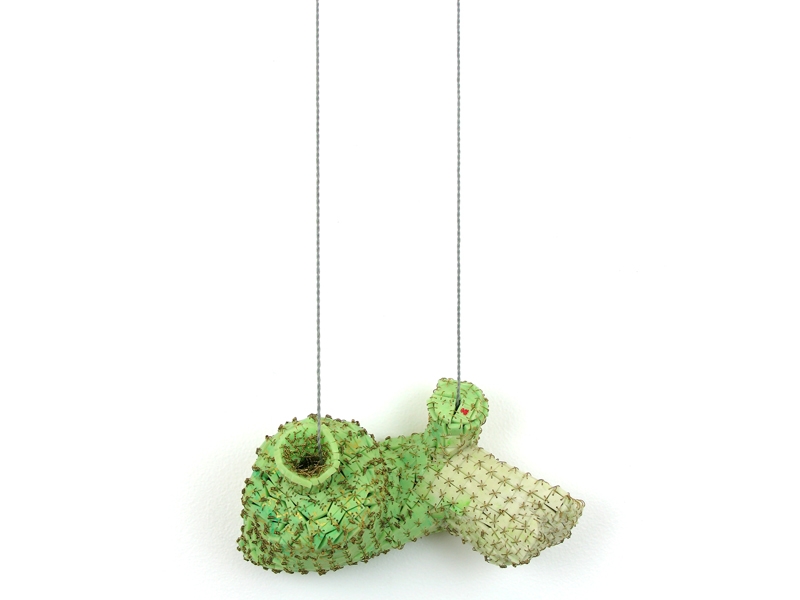
What does being a finalist mean for you? Do you think it will influence you going forward?
Bifei Cao: As an applicant who reached the age limit for this AJF award and recently graduated from school, this year is my last chance for this award, so it means a lot for me to be one of the finalists. It will help build my confidence both in making and teaching. Being a finalist helps me go forward and encourages me to be a maker for the rest of my life.
作为一个申请者,年龄接近了AJF奖项的年龄限制,但有刚刚从学校毕业,能够从这么多申请者中入选实属幸运。今年我赶上末班车,入选对我意义重大:不断重塑我对创作和教学的自信,也让我坚定创作者这个身份在我一生的位置。
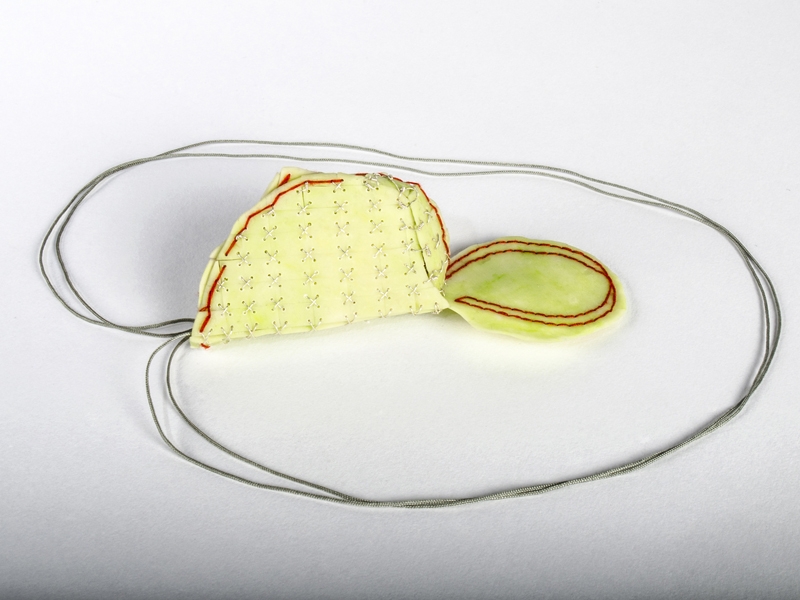
Tell us about the work you submitted for the competition.
Bifei Cao: The Vase Series is a continual investigation I completed after my PhD from Australia. Referenced from traditional objects that are used daily in China, such as a jar and vase in classic Chinese pottery, each work deploys a dissolving and reshaping position to reflect on the temporality of our cultural situation.
《瓶》系列是完成博士学位后的继续研究。灵感来源于中国传统陶瓷日用器皿,比如经典中国陶瓷器皿中的罐和瓶。每件作品表达一个熔化和重塑的状态,来反映我们文化状态的临时性。
In these works, I intended to reinterpret a historic joining method used for a jade burial suit made during the Han Dynasty in China. Through linking and twisting thin metal wires, all of the small jade parts were united to function as body protection and were a symbolic host for the spirit. Introducing this ancient but innovative method of connection to my work is consistent with my approach of bringing traditional techniques into contemporary life.
在这些作品中,我试图重新诠释中国汉代时期的“金缕玉衣”这一传统联接方法。这种传统方法通过金属丝的联接和固定,将所有小的玉片连成玉衣用来保护皇家贵族逝去的躯壳和灵魂。重新创新这一传统方法,不仅让我学习传统,也将中国传统与当代生活结合起来进行创作。
Through these works, I sought to reflect on how we understand cultural difference and our relation to these negotiations of cultures. I reflected on how, in a globalized and multicultural society, cultural identity shifts to a hybrid situation and waits for reconstruction through complicated negotiations between one’s original cultural background and references from other cultures.
通过这些作品,我试图反映我们怎么样去理解不同的文化和我们在文化间交流下的关系。在国际下多文化环境与社会,文化身份不断进入一个杂合阶段,不断在个人的本源文化和其他文化影响中进行复杂的碰撞与重塑。

What excites you about the art jewelry field?
Bifei Cao: The most exciting thing about the art jewelry field is this cross-disciplinary research. Artists have brought their knowledge and research from other fields, such as archaeology, anthropology, anatomy, and science, to the field, which leads to diverse and interesting works in the field.
艺术首饰领域最让我兴奋的是那些交叉学科的研究。艺术家通过研究其他领域,比如考古学、人类学、解刨学和不同科学,从而让艺术首饰领域变得更加多元和有趣。
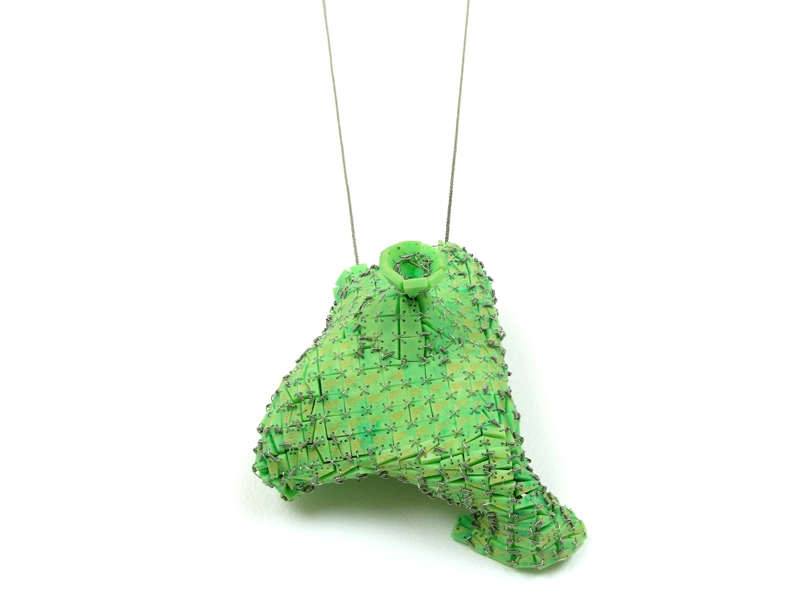

Where do you think the art jewelry field is going? Are there new and exciting trends that you see?
Bifei Cao: I am afraid that I am not up to date enough to review the contemporary art jewelry field. However, I am fascinated by artists who have persistently pursued their own directions. For example, artists such as Robert Baines and David Huycke utilize traditional techniques and related concepts, while artists such as Lucy Sarneel, Mari Funaki, and Daniel Kruger have been influenced by tradition. I do believe a lot of artists are passionate about new technology and materials to combine with their own ideas.
我也抱歉我没有太关注当代艺术首饰发展的状态。但是,我常常被那些有着直接目标的艺术家作品所吸引。比如:Robert Baines 和David Huycke两位艺术家专注传统工艺与相关理念,而艺术家Lucy Sarneel、Mari Funaki 和Daniel Kruger三位艺术家对传统的挖掘。我也坚信,很多艺术家对新工艺和新材料有着浓厚的兴趣,希望溶入他们的创作理念中。
I don’t know any trends, but I adore those artists who have very clear and clever ideas, such as David Bielander and Simon Cottrell. I am excited when I see these works.
我不知道任何流行趋势,但是我非常喜欢那些有着非常清晰和聪明的概念的艺术家们,比如David Bielander 和 Simon Cottrell。看到他们的作品让我兴奋。
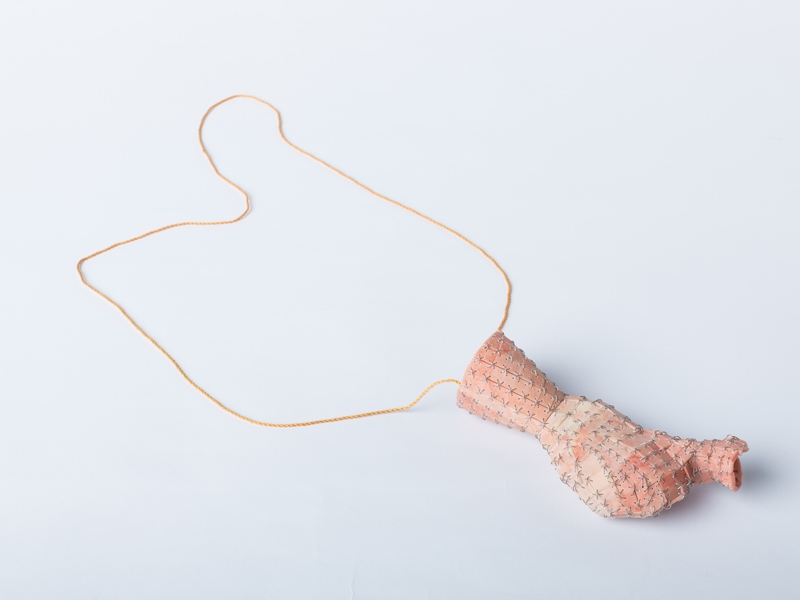
If you could write a master plan for your practice, where would you like to be five years from now?
Bifei Cao: My master plan will involve utilizing traditional Chinese crafts and their related philosophies. My current work has always been inspired by traditional Chinese visual culture and my life experiences, both in China and overseas. I plan to stay in Yunnan province, in the southwest of China, to do this traditional research. Recently, I began to research a natural herbaceous plant, Gerbera delavayi, used by the Yi nationality of China for making clothes. I would like to learn this traditional craft and see where it will take me. As a permanent US resident, I would like to share my knowledge and reinterpretation of Chinese traditions with the world and contribute to cultural communication between both countries. I plan to live in both countries in the next five years.
我的大计划是继续学习和创新中国传统工艺以及相关哲学理念。我目前的作品来源于中国传统视觉文化和我个人海内外的生活履历。我打算在中国西南部的云南省地区进行传统田野调研。最近的一次考察,我开始对彝族的火草制衣工艺很感兴趣,我想接着去学习和找到我感兴趣的原因。作为一个美国永久居民,我也希望将我的知识和对中国文化传统的理解介绍给美国和全世界文化爱好者,为中美以及和其他国家的文化交流做出贡献。接下来的5年,我打算主要居住在这两个国家。
Congratulations again! Thank you very much.
Bifei Cao: Thanks so much!
非常感谢!
